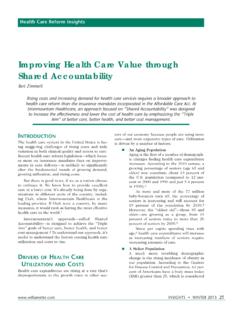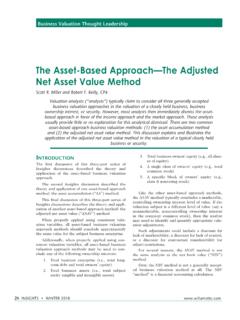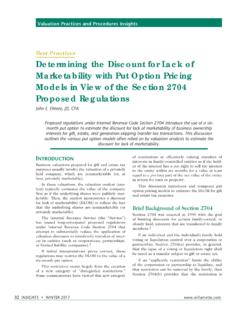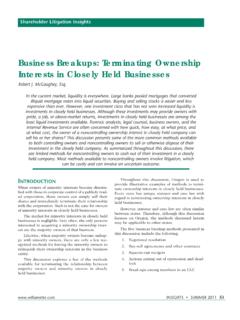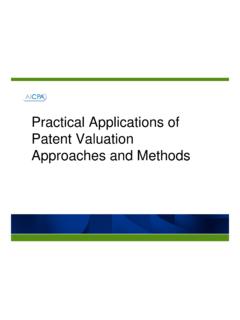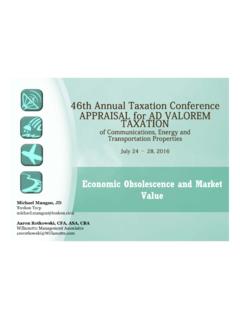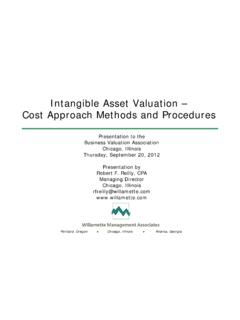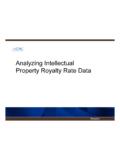Transcription of The Valuation of Trademark-Related Intangible Property
1 66 insights winter 2015 www .willamette .comIntroductIonTrademarks present a difficult but interesting chal-lenge from a Valuation , damages, and transfer price perspective. They represent an important tool of commerce and can become very valuable. Forbes magazine recently listed the Google trademark as the world s most valuable at $44 billion, exceeding the gross domestic product of many small discussion describes the factors that are rel-evant to the Valuation , damages, and transfer price of Trademark-Related Intangible Property in a variety of contexts, including financial accounting and tax- related transfer discussion explains the generally accepted trademark Valuation approaches and methods as it applies to these contexts. And this discussion presents three examples to illustrate the trademark analysis approaches and methods oF Trademark-Related IntangIB le propertyWhat is a trademark and what economic advantages does it provide?
2 Under the trademark Act of 1947 (the Lanham Act), the statutory federal laws govern-ing trademark rights, a trademark is defined as any word, name, symbol, or design, or any combination thereof, used in commerce to identify and distin-guish the goods of one manufacturer or seller from those of another and to indicate the source of the goods. 1At its essence, a trademark is an economic tool to help consumers to assess the quality of goods and services in making a purchase decision based on the reputation of the manufacturer or that provide higher quality products enjoy more goodwill in the mind of typical con-sumers than those that do not. Advertising plays an important role in shaping and reinforcing this and other corporate executives tend to conflate a trademark with the marketing concept of a brand. Indeed, the two concepts may be hard for laypersons to distinguish, particularly where a trademark represents an entire business enterprise like it does for Google.
3 For this reason, many layper-sons use the terms , this conflation of the terms trademark and brand is not technically correct. A trademark , at its essence, serves as but one identifier of a brand it does not reflect the entirety of the brand itself. Think of it this way: a business with a good reputation can enjoy an advantage over a competi-tor even if it employs no Valuation of Trademark-Related Intangible PropertyJohn E. Elmore, JD, CPAI ntangible Property Transfer Price InsightsValuation analysts are often called on to perform Valuation , damages, and transfer price analyses of Trademark-Related Intangible Property for various purposes. This discussion describes the Valuation of trademarks within the context of both financial accounting and income tax accounting (in particular, tax- related intercompany transfer pricing). This discussion summarizes the generally accepted trademark analysis approaches and methods, particularly within the context of financial accounting and tax- related transfer price analysis.
4 And, this discussion presents three examples, using different analytical methods, to illustrate the analysis of Practiceswww .willamette .com insights winter 2015 67 Customers, for example, may distinguish the business by its location or owner, or the business may simply employ names or symbols for which it possesses no trademark rights. It follows that the value of a trademark ordinarily is something less than the value of a confusing the distinction between a brand and a trademark for nonpractitioners is the use of trade names. A trade name is a name used to identify a business. But unless it is also registered as a trademark , or recognized under common law as a trademark , it generally carries no legal rights of protection and has no material value as an asset for Valuation is also true of domain names.
5 A domain name is part of a web address that links to the inter-net protocol (IP) address of a particular website. Registration of a domain name with a domain name registrar provides no trademark protection; instead, a separate trademark registration is is true for other intellectual Property , a trademark conveys a bundle of legal rights and protections to its owner. These rights include the right to exclude others from employing the trade-mark if such use would cause confusion in the the entire bundle of rights is transferred to another party, an assignment is given. Anything less than a transfer of the entire bundle of rights is a license. The licensee pays for those rights by means of a regIstratIonTrademarks are created through use and do not require registration. Registration is generally rec-ommended, however, because it offers additional benefits over common law trademark trademark can be recognized under common law in the geographic area in which it is used, the channel of trade in which the goods or services are sold, and for the goods or services with which the trademark is used.
6 A trademark is registered with the United States Patent and trademark Office (USPTO) via an appli-cation process. Registration provides constructive notice to the public of the registrant s claim of exclusive rights to the trademark and serves as prima facia evidence of the ownership and validity of the a registration has been on the register for more than five years, has been in continuous use during that time, and has not been the subject of an adverse or pending proceeding, the registrant can file to have the trademark declared incontestable. Once a trademark is declared incontestable, the registration is deemed to be conclusive evidence of the exclusive right to use the registered mark in registration of a trademark with the USPTO remains in force for a 10-year term. An owner can renew the registration for successive 10-year terms upon filing an , strictly speaking, are marks used to identify goods.
7 Marks used to identify services are registered as service marks. For the purpose of this discussion, however, the term trademark will be used in the collective sense to refer to both trade-marks and service purposesThere are a myriad of reasons why analysts would be asked to value a trademark . Those reasons often fall into one of three buckets:1. Valuation for transactional purposes other than tax compliance2. Valuation for financial accounting purposes3. Valuation for income tax and other tax com-pliance purposesThe first bucket of reasons pertains broadly to transactions between parties that involve a trade-mark where the value of the trademark is necessary to define the terms of the transaction or otherwise complete the transaction. For example, a buyer may require independent assessment of a trademark s lender may require the Valuation of a trade-mark before the trademark can be pledged as part of the collateral for a second bucket of reasons pertains to finan-cial accounting requirements under the securities laws of governing jurisdictions.
8 In the United States, 68 insights winter 2015 www .willamette .comfederal securities law is enforced by the Securities and Exchange Commission (SEC). The SEC may, under certain circumstances, require the recogni-tion of trademarks and other Intangible Property on a reporting company s balance sheet. For example, this may occur when a trademark is acquired in a business combination. The SEC designated the Financial Accounting Standards Board (FASB) as the authoritative orga-nization in the private sector for standardizing gen-erally accepted accounting principles (GAAP) that govern the preparation of financial standards are known as the Accounting Standards Codification (ASC). ASC topic 805 gov-erns business combinations and requires the recog-nition of trademarks acquired as a result of a busi-ness merger or 2-5-5 of ASC topic 805 states:All identifiable Intangible assets that are acquired in a business combination should be recognized at fair value on the acquisi-tion date.
9 Identifiable Intangible assets are recognized separately if they arise from contractual or other legal rights or if they are separable ( , capable of being sold, transferred, licensed, rented, or exchanged separately from the entity).A trademark is recognized on a reporting com-pany s balance sheet as an Intangible asset separate from goodwill because it satisfies either of the fol-lowing two tests under paragraph 2-5-5:1. It arises from legal rights (remember, a trademark is essentially a bundle of rights)2. It is capable of being sold, transferred, and licensed separately from other assets of the acquiring companyThe recognition of an acquired trademark is per-formed as part of a purchase price allocation (PPA), whereby a portion of the price paid by the acquirer for all of the acquired assets is assigned to the trade-mark using an acceptable Valuation methodology.
10 Later, this discussion explores in more detail the Valuation of a trademark within a financial account-ing third bucket of reasons pertains to the anal-ysis of a trademark for tax compliance purposes. Many transactions involving the sale or transfer of trademarks qualify as taxable events. Income tax rules generally stipulate how the tax basis of trans-ferred assets is determined and what expenses asso-ciated with the assets are permissible for computing taxable important and challenging area of federal income tax compliance is known as intercompany transfer pricing. At a general level, intercompany transfer pricing involves the setting of prices for exchanges of goods, services, or use of intellectual Property , such as trademarks, between two or more controlled entities located in different tax , agreements are structured between sub-sidiaries of multinational corporations located in different countries with the aim of minimizing the total amount of corporate income tax paid.
